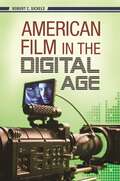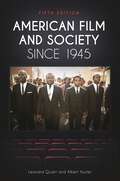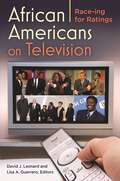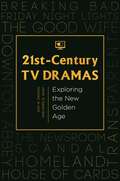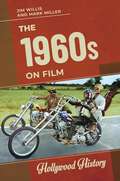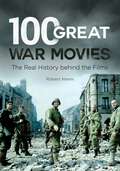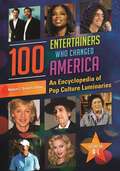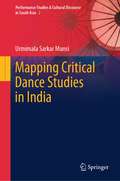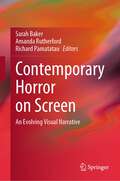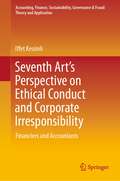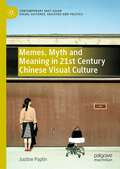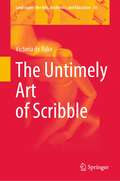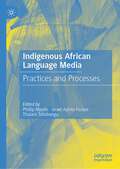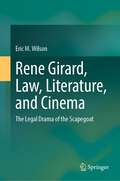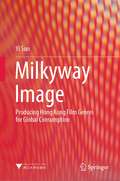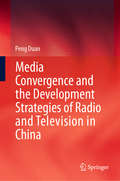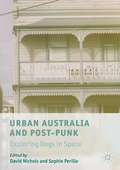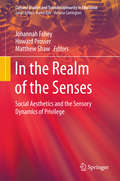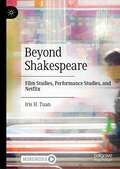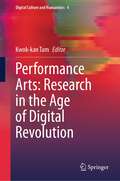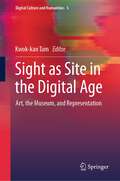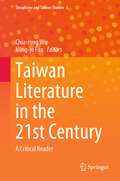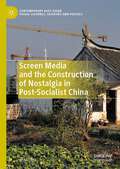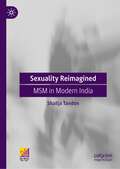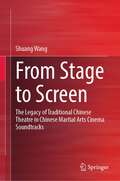- Table View
- List View
American Film in the Digital Age (New Directions in Media)
by Robert C. SickelsThis eclectic, yet comprehensive analytical overview of the cataclysmic changes in the American film industry since 1990 shows how they have collectively resulted in a new era—The Digital Age.The American film industry has entered a new era. American Film in the Digital Age traces the industrial changes since 1990 that have brought us to this point, namely: the rise of media conglomerates, the proliferation of pornography through peripheral avenues of mainstream media, the role of star actors and directors in distributing and publicizing their own pet projects, the development of digital technology, and the death of truly independent films. Author Robert Sickels draws straight lines from the movies to music, DVDs, video games, fast food, digital-on-demand, and more, to demonstrate how all forms of media are merging into one. He explores the irony that the success of independent films essentially killed independent cinema, showing how it has become almost impossible to get a film released without the imprimatur of one of the big six media companies—Fox, Viacom, TimeWarner, Disney, General Electric, or CBS. In the end, using recent, popular films as examples, he explains not only how we got where we are, but where we're likely headed as well.
American Film and Society since 1945
by Leonard Quart Albert AusterFrom Steven Spielberg's Lincoln to Clint Eastwood's American Sniper, this fifth edition of this classic film study text adds even more recent films and examines how these movies depict and represent the feelings and values of American society.One of the few authoritative books about American film and society, American Film and Society since 1945 combines accessible, fun-to-read text with a detailed, insightful, and scholarly political and social analysis that thoroughly explores the relationship of American film to society and provides essential historical context. The historical overview provides a "capsule analysis" of both American and Hollywood history for the most recent decade as well as past eras, in which topics like American realism; Vietnam, counterculture revolutions, and 1960s films; and Hollywood depictions of big business like Wall Street are covered. Readers will better understand the explicit and hidden meanings of films and appreciate the effects of the passion and personal engagement that viewers experience with films. This new edition prominently features a new chapter on American and Hollywood history from 2010 to 2017, giving readers an expanded examination of a breadth of culturally and socially important modern films that serves student research or pleasure reading. The coauthors have also included additional analysis of classic films such as To Kill a Mockingbird (1962) and A Face in the Crowd (1957).
African Americans on Television: Race-ing for Ratings
by David J. LeonardA comprehensive look at the history of African Americans on television that discusses major trends in black TV and examines the broader social implications of the relationship between race and popular culture as well as race and representation.Previous treatments of the history of African Americans in television have largely lacked theoretical analysis of the relationship between representations and social contexts. African Americans on Television: Race-ing for Ratings fills the existing void by supplying fundamental history with critical analyses of the racial politics of television, documenting the considerable effect that television has had on popular notions of black identity in America since the inception of television.Covering a spectrum of genres—comedy, drama, talk shows, television movies, variety shows, and reality television, including shows such as Good Times, The Oprah Winfrey Show, and Chappelle's Show—this insightful work traces a cultural genealogy of African Americans in television. Its chronological analysis provides an engaging historical account of how African Americans entered the genre of television and have continued to play a central role in the development of both the medium and the industry. The book also tracks the shift in the significance of African Americans in the television market and industry, and the changing, but enduring, face of stereotypes and racism in American television culture.
21st-Century TV Dramas: Exploring the New Golden Age
by Amy M. Damico Sara E. QuayIn its exploration of some of the most influential, popular, or critically acclaimed television dramas since the year 2000, this book documents how modern television dramas reflect our society through their complex narratives about prevailing economic, political, security, and social issues.Television dramas have changed since the turn of the 21st century—for the good, many would say, as a result of changes in technology, the rise of cable networks, and increased creative freedom. This book approaches the new golden age of television dramas by examining the programs that define the first 15 years of the new century through their complex narratives, high production value, star power, popularity, and enthusiastic fan culture.After an introduction that sets the stage for the book's content, thematic sections present concise chapters that explore key connections between television dramas and elements of 21st-century culture. The authors explore Downton Abbey as a distraction from contemporary class struggles, patriarchy and the past in Game of Thrones and Mad Men, and portrayals of the "dark hero protagonist" in The Sopranos, Dexter, and Breaking Bad, as a few examples of the book's coverage. With its multidisciplinary perspectives on a variety of themes—terrorism, race/class/gender, family dynamics, and sociopolitical and socioeconomic topics— this book will be relevant across the social sciences and cultural and media studies courses.
The 1960s on Film (Hollywood History)
by Jim Willis Mark MillerThe 1960s on Film tells the narrative of the 1960s through the lens of the movie camera, analyzing 10 films that focus on the people, events, and issues of the decade.Films create both an impression of and — at times for younger audiences — a primary definition of events, people, and issues of an era. The 1960s on Film examines the 1960s as the decade was presented in ten films that focused on that decade. Discussion will focus on both what the films have to say about the era and how close they come to accurately depicting it.For example, films such as Mississippi Burning and Selma tell the story of racial conflict and hope for reconciliation in the 1960s. Other films such as The Right Stuff and Hidden Figures show the deep fascination America had at that time with the burgeoning space program and NASA, while Easy Rider analyzes the role of rock music and drugs among young people of the decade. The Deer Hunter studies the controversies surrounding the war in Vietnam. The Graduate, Mad Men, JFK, and Thirteen Days also receive significant treatment in this exciting volume.
100 Great War Movies: The Real History behind the Films
by Robert J. NiemiThis book serves as a fascinating guide to 100 war films from 1930 to the present. Readers interested in war movies will learn surprising anecdotes about these films and will have all their questions about the films' historical accuracy answered.This cinematic guide to war movies spans 800 years in its analysis of films from those set in the 13th century Scottish Wars of Independence (Braveheart) to those taking place during the 21st-century war in Afghanistan (Lone Survivor). World War II has produced the largest number of war movies and continues to spawn recently released films such as Dunkirk. This book explores those, but also examines films set during such conflicts as the Napoleonic Wars, the American Civil War, World War I, the Vietnam War, and the wars in Afghanistan and Iraq.The book is organized alphabetically by film title, making it easy to navigate. Each entry is divided into five sections: Background (a brief discussion of the film's genesis and financing); Production (information about how, where, and when the film was shot); Synopsis (a detailed plot summary); Reception (how the film did in terms of box office, awards, and reviews) and "Reel History vs. Real History" (a brief analysis of the film's historical accuracy). This book is ideal for readers looking to get a vivid behind-the-scenes look at the greatest war movies ever made.
100 Entertainers Who Changed America [2 volumes]: An Encyclopedia of Pop Culture Luminaries [2 volumes]
by Robert C. SickelsThis fascinating and thought-provoking read challenges readers to consider entertainers and entertainment in new ways, and highlights figures from outside the worlds of film, television, and music as influential "pop stars."Comprising approximately 100 entries from more than 50 contributors from a variety of fields, this book covers a wide historical swath of entertainment figures chosen primarily for their lasting influence on American popular culture, not their popularity. The result is a unique collection that spotlights a vastly different array of figures than would normally be included in a collection of this nature—and appeals to readers ranging from high school students to professionals researching specific entertainers.Each subject individual's influence on popular culture is analyzed from the context of his or her time to the present in a lively and engaging way and through a variety of intellectual approaches. Many entries examine commonly discussed figures' influence on popular culture in ways not normally seen—for example, the widespread appeal of Woody Allen's essay collections to other comedians; or the effect of cinematic adaptations of Tennessee Williams' plays in breaking down Hollywood censorship.
Mapping Critical Dance Studies in India (Performance Studies & Cultural Discourse in South Asia #2)
by Urmimala Sarkar MunsiThis book provides a critical understanding of dance studies in India, bringing together various embodied practices identified loosely as dance. It suggests an alternative reading of the history of patronage, policies, and institutionalized understanding of categories such as classical, folk, modern, popular, and Bollywood that hierarchizes some dances as 'more' dance than others. It is of great interest to scholars looking at performing arts such as dance as a tool for identity assertions. It offers diverse possibilities of understanding dance through its inherent sociopolitical possibilities as a participatory or presentational tool for communication. The multidisciplinary approach brings together perspectives from critical dance studies, anthropology, history, and gender studies to connect embodied archives of different communities to create an intersectional methodology of studying dance in India as a powerful but marginal expressive art practice. Accessible at multiple levels, thecontent is relevant for undergraduate and postgraduate students, as well as researchers across dance, dance education, theatre, and performance studies.
Contemporary Horror on Screen: An Evolving Visual Narrative
by Sarah Baker Amanda Rutherford Richard PamatatauThis book highlights how horror in film and television creates platforms to address distinct areas of modern-day concern. In examining the prevalence of dark tropes in contemporary horror films such as Get Out, Annabelle: Creation, A Quiet Place, Hereditary and The Nun, as well as series such as Stranger Things, American Horror Story and Game of Thrones, amongst numerous others, the authors contend that we are witnessing the emergence of a ‘horror renaissance’. They posit that horror films or programmes, once widely considered to be a low form of popular culture entertainment, can contain deeper meanings or subtext and are increasingly covering serious subject matter. This book thus explores how horror is utilised as a tool to explore social and political anxieties of the cultural moment and is thus presented as a site for contestation, exploration and expansion to discuss present-day fears. It demonstrates how contemporary horror reflects the horror of modern-day life, be it political, biological, social or environmental. A vital contribution to studies of the horror genre in contemporary culture, and the effect it has on social anxieties in a threatening and seemingly apocalyptic time for the world, this is a vital text for students and researchers in popular culture, film, television and media studies.
Seventh Art’s Perspective on Ethical Conduct and Corporate Irresponsibility: Financiers and Accountants (Accounting, Finance, Sustainability, Governance & Fraud: Theory and Application)
by Iffet KesimliThis book discusses the possibility of corporate professionals—specifically accountants, bankers, and financiers—being influenced by the seventh art, i.e. cinema, and acting out fraudulent actions depicted in the cinematic world in the real life situations. It is widely known that real world scenarios influence cinema. Through a field study, this book evaluates if there is a reciprocal effect on events in the real world being impacted by scenarios depicted in movies. A questionnaire was designed in order to understand the perception of business ethics among above-mentioned professionals and if such a perception was formed or influenced due to observed behaviors from movies. The book concludes with an assessment of the power of visual art in affecting real world behaviors and outlines strategies for recognizing and preventing such behaviors leading to unethical conduct and corporate irresponsibility.
Memes, Myth and Meaning in 21st Century Chinese Visual Culture (Contemporary East Asian Visual Cultures, Societies and Politics)
by Justine PoplinThis book explores the impact of global change in China in what is considered in the West as ‘the Asian century’ and what this in turn means for visual culture. Unravelling a deep understanding of historical shifts in visual culture that represent socio-political mirrors of culture, it expands the Western perception of Chinese visual culture and the intertwined complexities of cultural signification. This book provides a key resource for Galleries and Academic Institutions, offering insights into understanding the systems underpinning ideas, skills and influences of the new visual culture in the Asian century.
The Untimely Art of Scribble (Landscapes: the Arts, Aesthetics, and Education #34)
by Victoria de RijkeThis book offers new definitions, vocabularies and insights for “scribbling”, viewing it as a fascinating and revealing process shared by many different disciplines and practices. The book provides a fresh and timely perspective on the nature of mark making and the persistence of the gestural impulse from the earliest graphic marks to the most sophisticated artistic production. The typical treatment of scribbling in the literature of artistic development has cast the practice as a prelude to representation in drawing and writing, with only occasional acknowledgment of the continuing joy and experiment of making marks across many arts practices. The continuous line the author traces between the universal practice of scribbling in infancy and early childhood and the work of radical creativity for contemporary and historical artists is original and clarifying, expanding the range of drawing behaviors to that of avant-garde painters, performance and the digital.
Indigenous African Language Media: Practices and Processes
by Phillip Mpofu Israel Ayinla Fadipe Thulani TshabanguThe book contributes to the sparse academic literature on African and minority language media research. It serves as a compendium of experiences, activities and case studies on the use of native language media. Chapters in this book make theoretical, methodical and empirical contributions about indigenous African language media that are affected by structural factors of politics, technology, culture and economy and how they are creatively produced and appropriated by their audiences across African cultures and contexts. This book explores indigenous African language media about media representations, media texts and contents, practice-based activities, audience reception and participation, television, popular culture and cinema, peace and conflict resolution, health and environmental crisis communication, citizen journalism, ethnic and identity formation, beat analysis and investigative journalism, and corporate communication. There are hardly any similar works that focus on the various issues relating to this body of knowledge. The book provides a valuable companion for scholars in various fields like communication, media studies, African studies, African languages, popular culture, journalism, health and environmental communication.
Rene Girard, Law, Literature, and Cinema: The Legal Drama of the Scapegoat
by Eric M. WilsonThis book is the first monograph to critically evaluate the work of the literary scholar René Girard from the perspectives of Law and Literature and Law and Film Studies, two of the most multidisciplinary branches of critical legal theory. The central thesis is that Girard’s theory of the scapegoat mechanism provides a wholly new and original means of re-conceptualizing the nature of judicial modernity, which is the belief that modern Law constitutes an internally coherent and exclusively secular form of rationality. The book argues that it is the archaic scapegoat mechanism – the reconciliation of the community through the direction of unified violence against a single victim – that actually works best in explaining all of the outstanding issues of Law and Literature in both of its sub-forms: law-as-literature (the analysis of legal language and practice exemplified by literacy texts) and law-in-literature (the exploration of issues in legaltheory through the fictitious form of the novel). The book will provide readers with: (i) a useful introduction to the most important elements of the work of René Girard; (ii) a greater awareness of the ‘hidden’ nature of legal culture and reasoning within a post-secular age; and (iii) a new understanding of the ‘subversive’ (or ‘enlightening‘) nature of some of the most iconic works on Law in both Literature and Cinema, media which by their nature allow for the expression of truths repressed by formal legal discourse.
Milkyway Image: Producing Hong Kong Film Genres for Global Consumption
by Yi SunThis book adopts an integrative research framework that primarily combines industrial and discourse analysis to investigate the company Milkyway Image, drawing upon literature that studies film studios and the practices of film production, distribution, and reception. The history of the Hong Kong-based film production company Milkyway Image from its founding in 1996 to the present exemplifies the metamorphosis of the post-return Hong Kong film industry to an era characterised by Hong Kong’s integration into a Chinese national context and the transnationalisation of world cinema. It shows that contemporary Hong Kong cinema’s transition resists a monolithic chronicle and instead represents a narrative combining the perspectives of different interest groups and a complex process of compliance and resistance, negotiation and contestation. The meaning of Milkyway’s films shifts as they are circulated across cultures and viewed within diverse frameworks, and our understanding of Hong Kong cinema is subject to varying contexts and historical configurations. For researchers in film and media studies and those who have a general interest in Hong Kong cinema, Asian cinema, or contemporary film culture, this book reveals how a variety of industry and cultural bodies have become co-creators of meaning for a film production house, and how the company operates as a co-creator of the discourse that surrounds it.
Media Convergence and the Development Strategies of Radio and Television in China
by Peng DuanThis book discusses the development strategies of Chinese media convergence in the current, fast-changing communication environment. Drawing on both theoretical and empirical data and based on the author’s observations, focus groups, and in-depth analyses of selected Chinese radio and TV networks, it illustrates key lessons for the maintenance and future improvement of talents, advertisement, media organization management, business development, and coping strategies. Further, it outlines a framework that helps readers to consider how to use communication strategies for the construction of media convergence in the context of China by referring to theories of international communication and political communication.Presenting research on the development strategies of Chinese media convergence, it offers a systematic study of the processes through which the Chinese radio and television industries make use of proper communication strategies to have a profound global influence.
Urban Australia and Post-Punk: Exploring Dogs in Space
by David Nichols Sophie PerilloRichard Lowenstein’s 1986 masterpiece Dogs in Space was and remains controversial, divisive, compelling and inspirational. Made less than a decade after the events it is based on, using many of the people involved in those events as actors, the film explored Melbourne’s ‘postpunk’ counterculture of share houses, drugs and decadence. Amongst its ensemble cast was Michael Hutchence, one of the biggest music stars of the period, in his acting debut. This book is a collection of essays exploring the place, period and legacy of Dogs in Space, by people who were there or who have been affected by this remarkable film. The writers are musicians, actors and artists and also academics in heritage, history, urban planning, gender studies, geography, performance and music. This is an invaluable resource for anyone passionate about Australian film, society, culture, history, heritage, music and art.
In the Realm of the Senses: Social Aesthetics and the Sensory Dynamics of Privilege (Cultural Studies and Transdisciplinarity in Education)
by Johannah Fahey Howard Prosser Matthew ShawThis book charts new territory both theoretically and methodologically. Drawing on MacDougall’s notion of social aesthetics, it explores the sensory dimensions of privilege through a global ethnography of elite schools. The various contributors to the volume draw on a range of theoretical perspectives from Lefebvre, Benjamin, Bourdieu, Appadurai, Kress and van Leeuwen to both broaden and critique MacDougall’s original concept. They argue that within these elite schools there is a relationship between their ‘complex sensory and aesthetic environments’ and the construction of privilege within and beyond the school gates. Understanding the importance of the visual to ethnography, the social aesthetics of these elite schools are captured through the inclusion of a series of visual essays that complement the written accounts of the aesthetics of privilege. The collection also includes a series of vignettes that further explore the sensory dimension of these aesthetics: touch, taste—though metaphorically understood— sight and sound. These varying formats illustrate the aesthetic nature of social relations and the various ways in which class permeates the senses. The images from across the different schools and their surroundings immerse the reader in these worlds and provide poignant ethnographic data of the forces of globalisation within the context of elite schooling.
Beyond Shakespeare: Film Studies, Performance Studies, and Netflix
by Iris H. TuanWith joy and grace to accompany the readers to have the translocal tour to visit about thirty-seven works, this monograph applies the academic critical theories of Performance Studies, Film Studies, Psychoanalysis, Postmodernism, and Visual Culture, to interpreting the special selection works. The focus and common theme are on race, body, and class. With the background of COVID-19 since 2019 up to the present, the book offers the readers with the remarkable insight of human beings’ accumulated wisdom and experiences in surviving with the dreadful diseases like the plagues in Shakespeare’s time. After the supreme reading, may the global readers in the world acquire the knowledge and power to live in sustainability with education and entertainment of films, performances, and online streaming Netflix TV dramas.
Performance Arts: Research in the Age of Digital Revolution (Digital Culture and Humanities #4)
by Kwok-Kan TamThis volume reshapes a contemporary understanding of research in theatre and performance arts. Bringing together distinguished scholars from all over the world, the book serves as an arena for international scholars to introduce innovative research methodologies and disseminate their research findings regarding VLT, data archiving, and digital history and discusses the impacts of digital culture in art production, stage performance, film, and literature. The Ibsen focus in the book is illustrative of the power of digital database research that is generating new relations in spatial-historical dimensions that have otherwise gone unnoticed. It demonstrates how a new methodology can bring practical benefits to handling big data with the support of digital technologies. In line with the post-pandemic landscape, this book engages a reflection on how the digital revolution has brought about changes and challenges, and constraints and breakthroughs within the field of theatre and performance arts. It is of appeal to theatre artists and practitioners, scholars, critics, librarians, digital archive engineers, and postgraduate students interested in theatre, performance studies, digital media, information technology, library science, communication, education, sociology, as well as political science. “The book investigates the latest methodological development in digital cultures and performance arts, which significantly contributes to the ever-changing and increasingly advanced technological culture in this field.” - Jessica Tsui-yan Li, York University, Canada"In line with the post-pandemic landscape, this book engages the reader in reflecting on how the digital revolution has brought about chances and challenges, constraints and breakthroughs to the field of theatre and performance arts. An original, eye-opening and inspiring volume at multiple levels, this book brings together distinguished scholars from all over the world." - Dr Anna Tso, The Hang Seng University of Hong Kong
Sight as Site in the Digital Age: Art, the Museum, and Representation (Digital Culture and Humanities #5)
by Kwok-Kan TamThis volume presents a broad coverage of theoretical issues that deal with digital culture, representation and ideology in art and museums, and other cultural sites, offering new insights into issues of representation in the digitization of art. It critically examines the roles of museum and archives in the digital age and reexamines the intricate relations between sight and site in art, museums, exhibitions, theme parks, theatre performances, music videos, and films. The collection represents a multidisciplinary approach to the complex issues underlying the advent of technologies and digital culture. The rise of visual culture since the twentieth century can be accounted for by the advent of technology in film, TV, museum exhibitions, and the wide use of websites, but it can also be understood as a paradigmatic shift toward representation as a visual means to interpret culture, with new understandings of the site-sight dilemma and the co-implications in related tensions. Complicating the issue of representation is the rise of digital culture, as digital sites replace actual physical sites. This book explores how the virtual has replaced the actual, and in what ways, and to what effects, the digital has displaced the physical. With contributions by museum curators, communications scholars, visual artists, theatre artists, filmmakers, literary critics, and historians, this volume is of appeal to academics and graduate students in information science, art, media, performance, literary and cultural studies, and history. “The book binds together different concepts such as site, sight and digitalization in a very original way. It convincingly gathers contributions from academics and practitioners, artists and museum specialists. The chapters are theoretically well-founded, show an interesting breadth of content and are also dealing with current developments.”— Monika Gänssbauer, Professor of Chinese and Head of the Institute of Asian, Middle Eastern and Turkish Studies, Stockholm University, Sweden “The chapters raise important and latest questions and discussions on the impact of digital technology has on art, culture, creativity, representation and innovation. They are original in dealing with latest examples in recent years, especially during the pandemic, with reflections and philosophical discussions on the transformation digital culture undergoes in relation to human and posthuman contexts, with examinations of art works, archives and museum collections, exhibitions, theme parks, theatre performances, films and music videos that encompass cultures from ancient to contemporary, from the West to the East, and from physical to digital.”— Jack Leong, Associate Dean of Research and Open Scholarship, York University Libraries, Toronto, Canada
Taiwan Literature in the 21st Century: A Critical Reader (Sinophone and Taiwan Studies #5)
by Chia-Rong Wu Ming-Ju FanThis book is an anthology of research co-edited by Dr. Chia-rong Wu (University of Canterbury) and Professor Ming-ju Fan (National Chengchi University). This collection of original essays integrates and expands research on Taiwan literature because it includes both established and young writers. It not only engages with the evolving trends of literary Taiwan, but also promotes the translocal consciousness and cultural diversity of the island state and beyond. Focusing on the new directions and trends of Taiwan literature, this edited book fits into Taiwan studies, Sinophone studies, and Asian studies.
Screen Media and the Construction of Nostalgia in Post-Socialist China: Contemporary East Asian Visual Cultures, Societies And Politics (Contemporary East Asian Visual Cultures, Societies and Politics)
by Zhun GuThis book traces the cultural transformation of nostalgia on the Chinese screen over the past three decades. It explores how filmmakers from different generations have engaged politically with China’s rapidly changing post-socialist society as it has been formed through three mutually constitutive frameworks: political discourse, popular culture and state-led media commercialisation. The book offers a new, critical model for understanding relationships between filmmakers, industry and the State.
Sexuality Reimagined: MSM in Modern India
by Shailja TandonThe book examines how medical knowledge is produced around bodies that do not fit in the heteronormative framework of the state’s rationale and processes. The marginal bodies studied in this research are termed MSM, men who have sex with men, categorized as a high-risk group in the backdrop of HIV/AIDS. These Queer bodies entered the registers of epidemiology and governmentality. This classification is the point of departure for the book. The book interrogates and asks how does a sexual subject become a political question? To answer this political trajectory, the book analyses the category of risk in biomedicine. It investigates how the category of risk becomes critical to the Indian state’s rationale and policies wherein, through the ambit of health and population, sexuality is managed. Unearthing the sexual politics in South Asia, the book, based on rich empirical evidence derived from the lived experiences of MSM, narrates the construction of sexual subjectivity and masculinity. The process of construction occurs in negotiation with the Indian state, bringing forth the dimension of the Indian state as a medico-legal governmentality regime and how MSM takes on the identity of a medicalized subject.
From Stage to Screen: The Legacy of Traditional Chinese Theatre in Chinese Martial Arts Cinema Soundtracks
by Shuang WangChinese martial arts cinema is held to be a synthesis drawing on artistic conventions of traditional Chinese theatre. Film sound and music perform as the legitimate heirs of some of the aesthetic ideas and norms of traditional Chinese theatre. This book critically examines the history of this under-explored field of inquiry from a theoretically comparative perspective, demonstrating that the musical codes drawn from traditional theatre are a constantly changing component integral to Chinese martial arts cinema. It explores the interaction between traditional Chinese theatre and Chinese martial arts cinema in how the musical codes of the former have shaped the aesthetics of the latter uniquely. This departs from conventional existing studies that focus on “adaptation.” The book’s historical and theoretical approach connects film, theatre and music, and re-defines the status of distinctive domains of filmic expression, grounding theatre as the pivot – or “hinge” – of film aesthetics. The book proffers this unique angle of research to rethink and re-imagine film sound and audiovisual synchronisation. Primarily intended for scholars in Chinese cinema, film music, Chinese theatre and visual culture, this monograph also presents introductory and comprehensive material for undergraduate and graduate-level courses in film and media studies, film music, Chinese cinema, and Chinese theatre.
